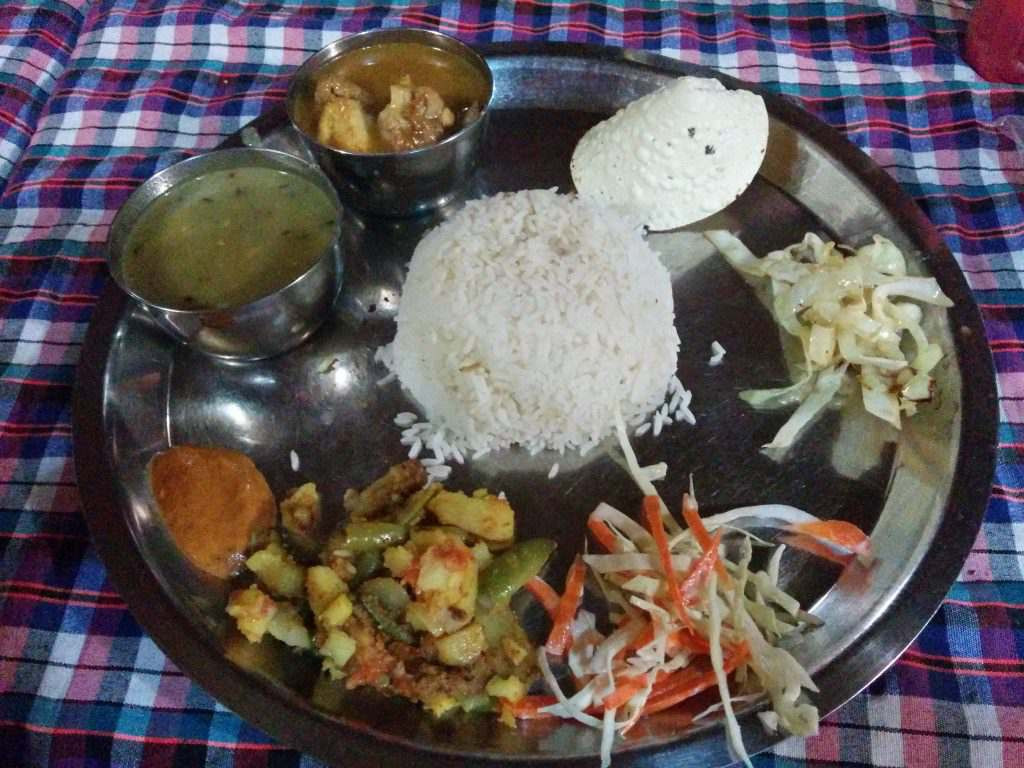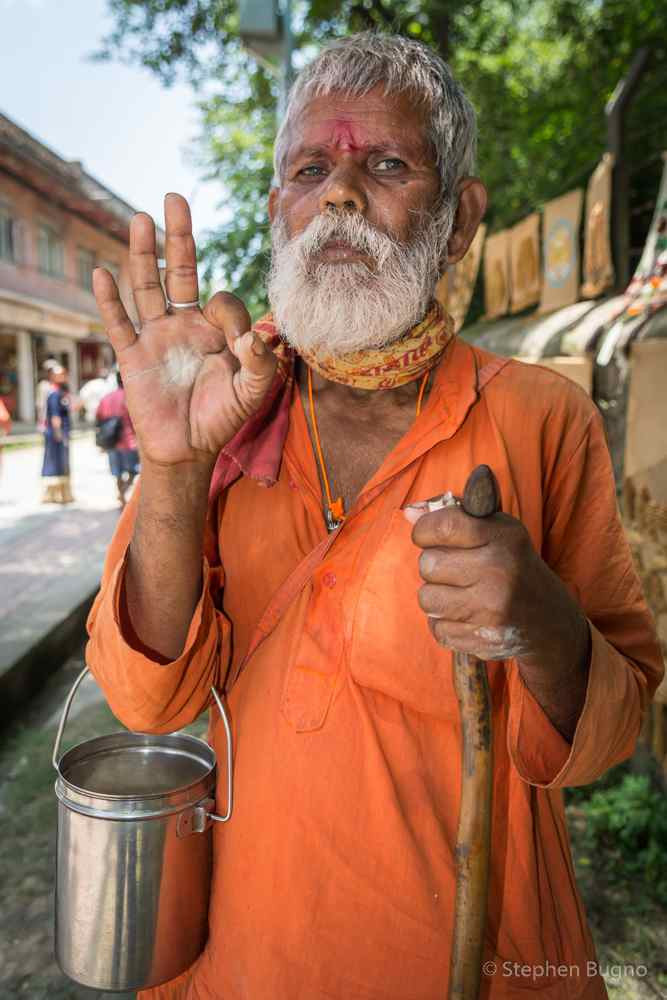Are you curious about the impact of tourism on Nepalese cuisine? Tourism significantly influences the food of Nepal by introducing new culinary trends, altering traditional dishes, and creating economic opportunities for local communities, and SIXT.VN is here to help you explore these culinary adventures. Discover how travel and food intertwine in this beautiful country, offering unique experiences for every palate, from traditional flavors to modern culinary creations; we will assist you from airport transfers to hotel bookings and exciting food tours. Plan your gastronomic adventure today with SIXT.VN.
1. What is the Impact of Tourism on Nepalese Food Culture?
Tourism profoundly impacts Nepalese food culture, introducing both positive and negative changes. On the one hand, it can lead to the preservation and promotion of traditional dishes, encouraging local communities to maintain their culinary heritage to attract tourists. On the other hand, it can also result in the homogenization of food, with international cuisines becoming more prevalent to cater to tourist preferences, potentially overshadowing local flavors.
- Preservation of Traditional Dishes: Tourism can incentivize the preservation of traditional Nepalese dishes like Dal Bhat, Momo, and Thukpa, as these are popular among tourists seeking authentic cultural experiences. According to a 2018 study by the Nepal Tourism Board, cultural tourism, including culinary experiences, contributes significantly to the country’s economy.
- Introduction of International Cuisines: To cater to a diverse range of tourists, many restaurants in popular tourist areas like Kathmandu and Pokhara offer international cuisines such as Italian, Chinese, and Continental. This can lead to a shift away from traditional Nepalese food among locals as well.
- Economic Opportunities: Tourism creates economic opportunities for local communities by promoting food-related businesses such as restaurants, cafes, and food stalls. These businesses provide employment and income, helping to improve the living standards of local people. According to research from the Nepal Rastra Bank in 2020, tourism contributes about 8% to Nepal’s GDP, a significant portion of which comes from food and beverage services.
SIXT.VN offers services that help tourists navigate the diverse food scene in Nepal, ensuring they experience both traditional and modern culinary offerings.
2. How Has Tourism Changed Traditional Nepalese Dishes?
Tourism has brought about several changes to traditional Nepalese dishes, primarily driven by the need to cater to the tastes and preferences of international visitors. These changes include modifications in ingredients, preparation methods, and presentation styles.
- Modification of Ingredients: Some traditional dishes have been altered to suit the palates of tourists. For example, spices may be toned down to reduce the heat level, or ingredients that are unfamiliar to tourists may be substituted with more common alternatives.
- Changes in Preparation Methods: Traditional cooking methods, which can be time-consuming and labor-intensive, may be streamlined to increase efficiency and reduce preparation time. This can result in a change in the flavor and texture of the dishes.
- Presentation Styles: The presentation of traditional dishes has also been influenced by tourism. Restaurants often adopt Western-style plating and presentation techniques to make the food more appealing to tourists.
According to a 2019 report by the Department of Tourism, Nepal, the adaptation of traditional dishes to suit tourist tastes is a growing trend in the hospitality sector. This has led to a debate about preserving the authenticity of Nepalese cuisine while catering to the demands of the tourism industry. SIXT.VN ensures you experience authentic culinary tours, preserving Nepal’s rich food heritage.
3. What are the Positive Effects of Tourism on the Food Industry in Nepal?
Tourism brings several positive effects to the food industry in Nepal, contributing to economic growth, cultural preservation, and the development of new culinary trends.
- Economic Growth: Tourism stimulates economic growth by creating jobs and income opportunities in the food sector. Restaurants, cafes, hotels, and food stalls benefit from the influx of tourists, leading to increased revenue and investment. According to the World Travel & Tourism Council, the tourism industry in Nepal generated NPR 240.7 billion (USD 2.0 billion) in 2019, supporting 1.05 million jobs.
- Cultural Preservation: Tourism can encourage the preservation of traditional culinary practices by creating demand for authentic Nepalese dishes. This incentivizes local communities to maintain their culinary heritage and pass it on to future generations.
- Development of New Culinary Trends: Tourism can also lead to the development of new culinary trends by introducing foreign influences and inspiring local chefs to experiment with new ingredients and techniques. This can result in the creation of fusion dishes that blend Nepalese flavors with international cuisines.
SIXT.VN supports local food businesses by connecting tourists with authentic culinary experiences, helping to boost the local economy and preserve cultural traditions.
 Dal Bhat Power 24
Dal Bhat Power 24
4. What are the Negative Effects of Tourism on the Food Industry in Nepal?
Despite its positive contributions, tourism also brings some negative effects to the food industry in Nepal, including the homogenization of food, increased food prices, and environmental concerns.
- Homogenization of Food: The influx of tourists can lead to the homogenization of food, with international cuisines becoming more prevalent and traditional Nepalese dishes being sidelined. This can result in a loss of culinary diversity and a decline in the authenticity of local food.
- Increased Food Prices: The demand for food from tourists can drive up prices, making it more expensive for local people to afford basic necessities. This can exacerbate existing inequalities and create social tensions.
- Environmental Concerns: Tourism can contribute to environmental problems such as food waste, pollution, and unsustainable agricultural practices. Restaurants and hotels often generate large amounts of food waste, which can strain local waste management systems.
SIXT.VN is committed to promoting sustainable tourism practices, including supporting eco-friendly restaurants and reducing food waste in the hospitality sector.
5. How Does Tourism Affect the Availability of Local Ingredients in Nepal?
Tourism can impact the availability of local ingredients in Nepal in several ways. Increased demand from restaurants and hotels catering to tourists can lead to shortages of certain ingredients, while the introduction of foreign crops and farming practices can alter local agricultural systems.
- Increased Demand: The growing tourism industry can create increased demand for local ingredients such as vegetables, fruits, and spices. This can lead to shortages if local farmers are unable to meet the demand, resulting in higher prices and the need to import ingredients from other regions or countries.
- Introduction of Foreign Crops: The introduction of foreign crops and farming practices can alter local agricultural systems and reduce the cultivation of traditional crops. This can lead to a loss of biodiversity and a decline in the availability of local ingredients.
- Impact on Traditional Farming: Tourism can also impact traditional farming practices by encouraging farmers to focus on producing crops that are in demand from tourists, rather than those that are essential for local consumption. This can disrupt traditional food systems and reduce the availability of local ingredients.
SIXT.VN partners with local farmers and suppliers to promote the use of local ingredients in restaurants and hotels, supporting sustainable agriculture and preserving traditional farming practices.
6. What Role do Local Restaurants Play in Promoting Nepalese Food to Tourists?
Local restaurants play a crucial role in promoting Nepalese food to tourists by offering authentic culinary experiences and showcasing the diversity of local cuisine. These restaurants serve as cultural ambassadors, introducing visitors to the flavors, ingredients, and traditions of Nepal.
- Offering Authentic Culinary Experiences: Local restaurants provide tourists with the opportunity to taste traditional Nepalese dishes prepared using authentic ingredients and cooking methods. This allows visitors to experience the true flavors of Nepal and learn about the country’s culinary heritage.
- Showcasing Diversity: Local restaurants showcase the diversity of Nepalese cuisine by offering a wide range of dishes from different regions and ethnic groups. This allows tourists to explore the various flavors and culinary traditions of Nepal, from the Himalayan highlands to the Terai lowlands.
- Cultural Ambassadors: Local restaurant owners and chefs serve as cultural ambassadors, sharing their knowledge and passion for Nepalese food with tourists. They often provide explanations of the dishes, ingredients, and cooking methods, enhancing the dining experience and promoting cultural understanding.
SIXT.VN recommends and partners with local restaurants that are committed to promoting Nepalese food and providing authentic culinary experiences to tourists, ensuring that visitors have the opportunity to taste the true flavors of Nepal.
 Kathmandu-0326
Kathmandu-0326
7. How Has Tourism Affected Food Hygiene and Safety Standards in Nepal?
Tourism has had a mixed impact on food hygiene and safety standards in Nepal. On the one hand, the need to cater to international tourists has led to improvements in hygiene and safety practices in some restaurants and hotels. On the other hand, many smaller establishments still lack adequate facilities and training, posing a risk to public health.
- Improvements in Hygiene and Safety Practices: To meet the expectations of international tourists, many restaurants and hotels in Nepal have invested in improving their hygiene and safety practices. This includes upgrading kitchen facilities, implementing food safety management systems, and training staff on proper hygiene procedures.
- Lack of Adequate Facilities and Training: Many smaller establishments, particularly those outside of major tourist areas, still lack adequate facilities and training. This can result in poor hygiene practices and an increased risk of foodborne illnesses. According to a 2017 report by the World Health Organization, foodborne diseases are a significant public health concern in Nepal, with an estimated 1.8 million cases occurring each year.
- Government Regulations: The Nepalese government has implemented regulations and standards to ensure food safety and hygiene in the tourism sector. However, enforcement of these regulations can be challenging, particularly in remote areas.
SIXT.VN partners with restaurants and hotels that adhere to high standards of food hygiene and safety, ensuring that tourists can enjoy their meals with peace of mind.
8. What are Some Popular Nepalese Dishes That Tourists Should Try?
Nepal offers a variety of delicious dishes that tourists should try to experience the country’s culinary heritage. Some of the most popular options include:
- Dal Bhat: This is the staple dish of Nepal, consisting of lentil soup (dal) and rice (bhat), usually served with vegetable curry, pickles, and sometimes meat. It’s a filling and nutritious meal that provides a taste of everyday Nepalese life.
- Momo: These are steamed dumplings filled with meat or vegetables, often served with a spicy dipping sauce. They are a popular snack or meal and can be found everywhere, from street stalls to high-end restaurants.
- Thukpa: This is a hearty noodle soup with vegetables and meat, often flavored with Tibetan spices. It’s a comforting and warming dish, perfect for cold days in the mountains.
- Chowmein: This is a stir-fried noodle dish with vegetables and meat, similar to Chinese chow mein but with a Nepalese twist. It’s a popular and affordable option for a quick meal.
- Sel Roti: This is a sweet, ring-shaped rice bread that is deep-fried and often eaten during festivals and celebrations. It’s a delicious and festive treat that provides a taste of Nepalese culture.
SIXT.VN provides information and recommendations on where to find the best local dishes, ensuring that tourists can fully experience the culinary delights of Nepal.
 Kathmandu-0295
Kathmandu-0295
9. How Can Tourists Support Sustainable Food Practices While Traveling in Nepal?
Tourists can support sustainable food practices while traveling in Nepal by making conscious choices about where they eat and what they consume. Some ways to do this include:
- Eating at Local Restaurants: Supporting local restaurants helps to boost the local economy and preserve traditional culinary practices.
- Choosing Eco-Friendly Establishments: Selecting restaurants and hotels that prioritize sustainability, such as those that use local ingredients, reduce waste, and conserve resources.
- Reducing Food Waste: Ordering only what you can eat and avoiding buffets can help to reduce food waste.
- Supporting Local Farmers: Buying produce and other food items from local farmers’ markets and cooperatives helps to support sustainable agriculture and reduce the carbon footprint of food production.
SIXT.VN encourages tourists to make sustainable choices and provides information on eco-friendly restaurants and hotels, helping them to support responsible tourism in Nepal.
10. What Culinary Tours and Experiences are Available for Tourists in Nepal?
Nepal offers a variety of culinary tours and experiences that allow tourists to immerse themselves in the country’s food culture. Some popular options include:
- Cooking Classes: Learning to prepare traditional Nepalese dishes in a hands-on cooking class.
- Food Tours: Exploring local markets and sampling street food with a knowledgeable guide.
- Homestay Experiences: Staying with a local family and participating in meal preparation and sharing.
- Farm Visits: Visiting local farms and learning about traditional agricultural practices.
- Tea Plantation Tours: Touring tea plantations and learning about the process of tea cultivation and production.
SIXT.VN offers a range of culinary tours and experiences, providing tourists with the opportunity to explore Nepal’s food culture in an authentic and meaningful way.
SIXT.VN: Your Gateway to a Culinary Adventure in Nepal
Planning your trip to Nepal and eager to dive into its rich culinary scene? Let SIXT.VN be your guide. We offer a range of services to ensure your culinary adventure is seamless and unforgettable:
- Personalized Itineraries: We craft itineraries tailored to your culinary preferences, ensuring you experience the best of Nepalese cuisine.
- Airport Transfers: Start your trip stress-free with our reliable airport transfer services.
- Hotel Bookings: Choose from a curated selection of hotels that offer exceptional dining experiences and sustainable practices.
- Culinary Tours: Join our expertly guided food tours to discover hidden culinary gems and authentic flavors.
- Expert Support: Our team is available to assist you with all your travel needs, from restaurant recommendations to logistical support.
Don’t let the challenges of planning a trip hold you back. Contact SIXT.VN today, and let us help you create the ultimate culinary adventure in Nepal. Whether you’re a solo traveler, a couple, or a family, we have the perfect services to meet your needs.
Address: 260 Cau Giay, Hanoi, Vietnam
Hotline/Whatsapp: +84 986 244 358
Website: SIXT.VN
 Annapurna-Trek-0114
Annapurna-Trek-0114
Frequently Asked Questions (FAQ) about Tourism and Food in Nepal
- How does tourism affect the authenticity of Nepalese food?
Tourism can lead to both preservation and alteration of traditional dishes. While some restaurants maintain authenticity to attract cultural tourists, others modify recipes to suit international palates. - What are the most popular Nepalese dishes among tourists?
Dal Bhat, Momo, Thukpa, and Chowmein are among the most popular dishes, offering a mix of flavors and culinary experiences. - Can tourism help in preserving traditional Nepalese cuisine?
Yes, tourism can incentivize local communities to preserve their culinary heritage by creating demand for authentic Nepalese dishes. - What are the negative impacts of tourism on the food industry in Nepal?
Negative impacts include the homogenization of food, increased food prices, and environmental concerns such as food waste. - How can tourists support sustainable food practices in Nepal?
Tourists can support sustainable practices by eating at local restaurants, choosing eco-friendly establishments, and reducing food waste. - What types of culinary tours are available for tourists in Nepal?
Culinary tours include cooking classes, food tours, homestay experiences, farm visits, and tea plantation tours. - How does the availability of local ingredients get affected by tourism in Nepal?
Increased demand can lead to shortages of local ingredients, while the introduction of foreign crops can alter local agricultural systems. - What role do local restaurants play in promoting Nepalese food to tourists?
Local restaurants offer authentic culinary experiences, showcase diversity, and serve as cultural ambassadors, promoting Nepalese food to tourists. - How has tourism influenced food hygiene and safety standards in Nepal?
Tourism has led to improvements in some establishments, but many smaller ones still lack adequate facilities and training. - How can SIXT.VN help in planning a culinary trip to Nepal?
SIXT.VN offers personalized itineraries, airport transfers, hotel bookings, culinary tours, and expert support to ensure a seamless and unforgettable culinary adventure.
SIXT.VN is your partner in discovering the rich and diverse food culture of Nepal. Book your trip today and embark on a culinary journey of a lifetime.



